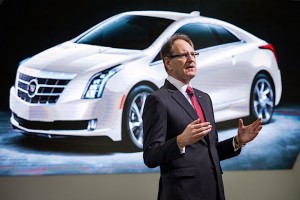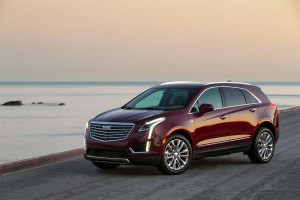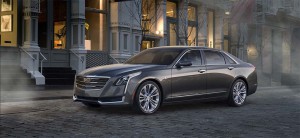While it might still bill itself “the standard of the world,” Cadillac has long been a largely American-focused luxury brand. But as it begins the most aggressive roll-out of new products in its 113-year history, the focus is increasingly shifting overseas.
Though an assault on the European market is on hold, according to Cadillac brand boss Johan de Nysschen, the marque’s future – and, thus, its product strategy – will be increasingly centered on China which is expected to soon become the world’s largest luxury car market.
“China has to be prioritized,” the South African-born executive stressed during a media drive of the new XT5 crossover-utility vehicle. Developing vehicles that appeal to that country’s increasingly affluent buyers must be “our primary mission.”
(Click Here for a review of the new Cadillac CT6 sedan.)
Cadillac’s shift in focus isn’t unique. Virtually every major global automaker has staked out a presence in the Asian nation, and Caddy’s parent, General Motors, now sells more vehicles there than in the U.S. Cadillac was actually a relative latecomer, however, and has been struggling to make up for lost time as it challenges Chinese luxury market leaders like Audi and Mercedes-Benz.
The GM brand recently launched its first production operation in China and soon plans to add its two newest models, the XT5 and the CT6 sedan. Significantly, a plug-in hybrid version of the flagship four-door was largely developed for China, where government leaders are pushing the auto industry to electrify in a frantic bid to reduce endemic smog problems. Caddy expects to sell only a small number of the Chinese-made CT6 PHEVs in the U.S., according to de Nysschen.
“Our electrification program is largely being driven by China,” noted de Nysschen, in a separate interview with TheDetroitBureau.com.
While Cadillac currently has but one electrified option, the battery-electric ELR, the plan is to offer “at least one and possibly more than one” different battery-based variant of “all new vehicles we develop” going forward, he added.
That will mean a lot of options for those looking for cleaner, more efficient alternatives. According to de Nysschen, Caddy plans eight all-new models by the end of the decade, and it will re-do three more.
Look for at least one current model, the XTS, to go away, according to various sources, while others will be renamed – notably the current ATS and CTS models. And along with the new XT5 and the big Escalade, look for three more utility vehicles to join the line, starting with a compact version to take on the likes of the BMW X3, as well as a three-row model above the XT5.
All the new models will feel at least some influence from China. Among other things, that will mean more lavish features – and room – in the back seat, as a sizable number of buyers there still prefer to be chauffeured.
While China will have an outsized impact on Cadillac’s near and mid-term strategy, Europe is not entirely off the radar. Cadillac has tried repeatedly to crack that market, only to run head-on into a virtually impenetrable barrier in the form of brands like Audi, BMW and Mercedes.
De Nysschen, who spent most of his career at Audi, is well aware of the challenge, but also knows the significant of eventually breaking through. “Europe is really important to us, but we have to bid our time,” he said cautiously, adding, “We have to go to Europe when we have the right products.”
He suggested it will “take us about five years” to get ready, a number in sync with the current portfolio plan.
(Cadillac opens new plant in China. Click Here for the story.)
Building a base in China will take time, as will rolling out the new products needed in the U.S. and other markets, de Nysschen is quick to caution. If anything, he warns that sales in the shifting American market may be weak for some time. Cadillac officials seemed almost surprise when they delivered a 2.5% increase in U.S. sales last year, the forecast calling for flat demand.
On a global scale, however, the brand saw a 7.5% increase and is looking to increase that pace once Chinese production of the XT5 and CT6 models gets underway.
For his part, de Nysschen continues to downplay short-term sales, however. Putting a focus on numbers, he contends, “perpetuates some of the bad practices that got Cadillac into trouble” over the last few decades. Sales “must be earned the hard way, and not bought through incentives.”
Indeed, by playing down incentives, the brand’s average transaction price rose by more than $5,000 last year, positioning it second only to Mercedes-Benz.
“The targets for our strategy are beginning to gain traction,” said de Nysschen.
(Cadillac developing new, high-performance V-8. Click Here for the inside story.)



